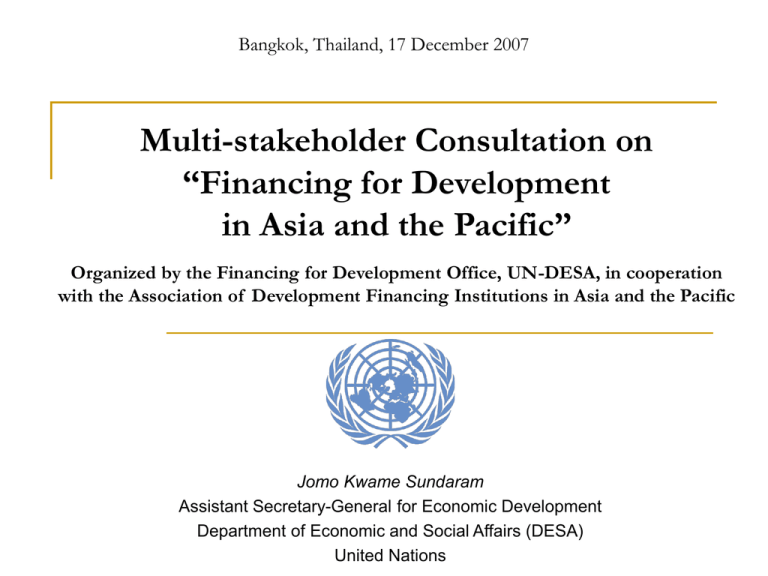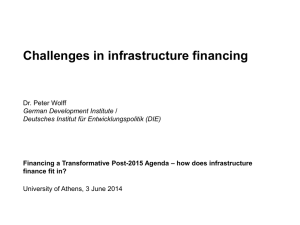Keynote address, Jomo Kwame Sundaram (Assistant Secretary-General for Economic Development Department of Economic and Social Affairrs, United Nations)
advertisement

Bangkok, Thailand, 17 December 2007 Multi-stakeholder Consultation on “Financing for Development in Asia and the Pacific” Organized by the Financing for Development Office, UN-DESA, in cooperation with the Association of Development Financing Institutions in Asia and the Pacific Jomo Kwame Sundaram Assistant Secretary-General for Economic Development Department of Economic and Social Affairs (DESA) United Nations Financing for Development process Monterrey Consensus, adopted at 2002 UN Conference on Financing for Development, recognized global partnership for development central to achieve internationally agreed development goals. Follow-up International Conference on Financing for Development (Doha, Qatar, 29 November - 2 December 2008): historic opportunity to review implementation of Monterrey Consensus, and address new challenges and emerging issues. 2 Mixed track record in implementation Since 2002, considerable advances in some areas, while progress modest or stagnation/regression in others. Despite decreasing share of poor in world population, poverty still increasing in many countries. Inequalities among and within countries also increasing. 3 Net transfer of financial resources from South to North Net outward financial flows from developing to developed countries increased from $728 bn in 2006 to $760 bn in 2007. Continued increases since 1998. Increase has not slowed in East and South Asia. Tying up investible funds as reserves reduces domestic investments, e.g. for infrastructure and services. Reserves build-up raises interest rates. 4 Net transfer of financial resources from South to North 200 Billions of US dollars 0 -200 -400 -600 -800 -1000 1995 1996 1997 Developing economies 1998 Africa 1999 2000 2001 2002 Eastern and Southern Asia 2003 2004 Western Asia 2005 2006 2007 Latin America Source: UN World Economic Situation and Prospects 2008 (forthcoming) 5 Multi-stakeholder consultations on Financing for Development How to reverse paradox of net transfers from South to North to mobilize resources for development. The Financing for Development Office (FfDO) of UNDESA has conducted various multi-stakeholder consultations in different regions on how to mobilize financing for development. Two current tracks deal with: Rethinking role of development finance institutions /National Development Banks (NDBs) Financing access to basic utilities for all 6 A. Rethinking role of development finance institutions/National Development Banks B. Financing access to basic utilities for all 7 A. Rethinking role of NDBs: Diversity of institutions Wide range of types of development financing institutions among and within regions. In Asia and the Pacific, at least five different subregions (Central Asia, South Asia, Northeast Asia, South East Asia, and the Pacific). Development Banks operate at different levels Global level (e.g. Islamic Development Bank), Regional level (e.g., Asian Development Bank, China Development Bank, Bank of Japan) National level, where they can be further divided into more specific categories (e.g. sectoral, provincial). 8 A. Rethinking role of DFIs/NDBs: Consultations FfDO organized multi-stakeholder consultations in Europe, Africa and Latin America, involving national development banks, governments, international organizations, financial institutions, private sector and civil society. Consultations reveal that NDBs/DFIs have critical role in economic and social development. 9 A. Rethinking role of DFIs/NDBs: General conclusions (I) DFIs have a development objective. Raisond’être is to bring finance to specific clients or projects that lack access to credit, particularly in medium and long term. Thus, DFIs should fill development gaps and address both market and state failures (e.g., in infrastructure investment). DFIs provide not only financial instruments (grants, loans, credits, guarantees, etc.), but also non-financial services (policy advice, technical assistance and capacity-building). 10 A. Rethinking role of DFIs/NDBs: General conclusions (II) Additional resources needed to develop financial instruments. When DFIs are banks, they have access to resources through clients and government deposits, but banking legislation imposes restrictions. When DFIs are not banks, harder to mobilize resources, but DFIs have greater flexibility to use them. DFIs often have complex structures. Different models to coordinate commercial and development activities (single organization or separate entities) seem viable. 11 A. Rethinking role of DFIs/NDBs: Action-oriented proposals Organize systematic sharing of information and cooperation among interested DFIs through regional associations: on regional, sub-regional and national development projects on best practices on governance and management on financial guidelines 12 A. Rethinking role of development finance institutions (DFIs)/National Development Banks (NDBs) B. Financing access to basic utilities for all 13 B. Financing Access to basic utilities for all: Consultations Consultations organized by Friedrich Ebert Foundation (FES), in cooperation with FfDO. Meetings held in Africa and Latin America, brought together experts from governments, utilities, civil society, private sector, and academia to develop policy options to improve financing for basic utilities in developing countries and to increase access for poor to water and electricity. 14 B. Financing Access to Basic Utilities for All: General conclusions (I) Discussions held from vantage of publicly owned utilities, taking into account domestic and international capital markets, macroeconomic factors, and internal revenue generation. Major conclusion: infrastructure spending needs increasing rapidly in developing countries. Central governments need sufficient policy space to set right spending priorities. Expenditure ceilings for municipalities should be reevaluated to make more resources available for infrastructure and social spending. 15 B. Financing Access to Basic Utilities for All: General Conclusions (II) Public providers can explore new innovative mechanisms for raising finance. Potential instruments include municipal bonds, pooled financing arrangements, and mechanisms provided by financial intermediary institutions. Emphasis should be on local currency mechanisms to minimize exchange-rate risk. Government subsidies remain indispensable. Government-subsidized entities, like national development banks, have proven effective for infrastructure financing in many developing countries. Experience shows government-subsidized institutions 16 can help develop local credit markets. B. Financing Access to Basic Utilities for All: General conclusions (III) Rather than crowding out investment, prudent public spending increases productive capacity and attracts private investment. In long run, citizens pay for provision of services, either through taxes or user fees. In short run, however, full-cost recovery often not realistic, if utilities to be provided to poor. More financial resources needed to help utilities invest in service extension and upgrade systems. 17 B. Financing Access to Basic Utilities for All: General conclusions (IV) Simplification, rationalization, and indexation of tariffs can help lower average charges to consumers and increase revenues. Reductions in connection or reconnection fees can help reach the poor and increase the revenue base. Increased focus on access subsidies, because they help extend networks and include poor, unconnected households. Services should remain affordable to the poor. Cross-subsidies successful in many countries. Most effective where administered simply. 18 Outcome of Multi-Stakeholder Consultations Outcome publications of multi-stakeholder consultations serve as substantive inputs to the Follow-up International Conference on Financing for Development (Doha, 29 November - 2 December 2008). 19 Thank you For more information please consult FfD website at www.un.org/esa/ffd or DESA website at www.un.org/esa Acknowlegements: Daniel Platz, FfDO, DESA, UN 20




